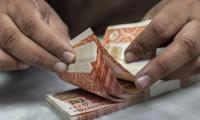LAHORE: When prices of essential commodities go up in Pakistan, bringing them back is impossible despite harsh measures. What actually happens is that the commodities that were available at high prices vanish from the markets after raids on hoarders.
Every time the administration claims that thousands of tons of sugar or wheat bags have been confiscated. Where do those confiscated goods go? Logically, the administration should dispose of the confiscated stocks at the government controlled price and make the payments thus received to the persons from whom the stocks were confiscated.
When the government is ordering wholesalers to sell at a given rate, there is no harm in disposing of confiscated goods at the controlled rates, and paying the hoarders after their case is decided by the courts.
If this principle is adopted, the commodities would be freely available in the market at reasonable rates and the shortages that persist after raids would go away. But when government sits on confiscated stocks it certainly increases shortages and puts further pressure on prices. If we look at the past history of commodity shortages, we find that a shortage of wheat occurred in February 1997 after Benazir Bhutto was removed by the then president of Pakistan.
Shahbaz government in Punjab took very harsh measures to bring loads of wheat trucks in the market. The shortage was so acute that some wheat flour was looted by the masses.
After that there was no shortage for almost nine year. The next shortage occurred in early 2008 near the end of Shaukat Aziz government that was accused of allowing wheat exports. Some Punjab lawmakers of the then ruling elite were accused of hoarding wheat stock. In the next 10 years when PPP and PML-N were in power there was no serious wheat shortage.
The wheat prices increased during the last two months again due to hoarding. Some serious efforts have removed shortages, but the commodity is still being sold at a little higher rate in Punjab, moderately high rates in Khyber Pakhtunkhwa, and extremely high rates in Sindh.
The latest episode clearly indicates that our rulers have not learnt their lesson from past similar episodes. In recent years, whenever the government allowed exporting sugar mostly through subsidy, domestic rates increased.
Data shows sufficient stocks are available to cover another eight months. It means the shortage is engineered. Sugar prices have been on the rise for the last few months, but instead of taking any action, the current government ignored the issue. Now, when sugar rates have reached an alarming level, the government has decided to take action.
However, unlike the case of wheat, where the administration seemed serious in controlling the price, in this case the state restricted its action to just raiding the stocks of wholesalers. It conveniently ignored the fact that sugar millers were sitting on huge stocks that they planned to export till a ban was slapped on sugar exports. If the sugar earmarked for exports was brought in the market, there would be no shortage and rates would also normalise.
Some quarters argue that there is no law that authorises the state to control prices, but then the hoarding along with engineered release of stocks by the mills through cartels was also against the law.
It seems that the Competition Commission of Pakistan has ignored the collusive behaviour of sugar mills. Moreover, the Federal Board of Revenue has also failed to collect actual taxes from the millers.
It accepts the sugar costing formula provided by the sugar mills in which sugar is shown as their main product. Based on that assumption, sugar cost is calculated on the percentage of sugar extracted from 100kg of sugarcane.
While the recovery declared by the mills is also disputable, even if their point is accepted, the entire cost of sugarcane crop plus overhead expenses cannot be passed on to sugar only. For most of the mills with distilleries, ethanol is the main product while sugar, bagasse (sugarcane waste after extraction of juice), and fertiliser (the residue left after extraction of sugar and ethanol) are by-products.
If we divide the cost on all these by-products the sugar cost would be lower. The government cannot force mills to sell at a specific rate, but if actual costs were calculated, the FBR would be able to recover taxes on the hefty profits that these manufacturers make on these products made from sugarcane. However, the FBR dare not touch the sugar tycoons who are extremely influential.
Chinese power company had intended to acquire up to 18.336 billion ordinary shares of K-Electric, representing 66.4...
MARI also successfully drilled and tested another appraisal well in the Mari Ghazij formation located in Mari D&PL
Gold rates decreased by $30 to $2,381 per ounce in the international market
Growing number of Americans have seen their savings dwindle as rising prices squeeze budgets while interest rates stay...
IMF will closely watch the privatization of PIA by the end of June
PSX lays down the groundwork to encourage listed companies to adopt ESG reporting in line with global standards







